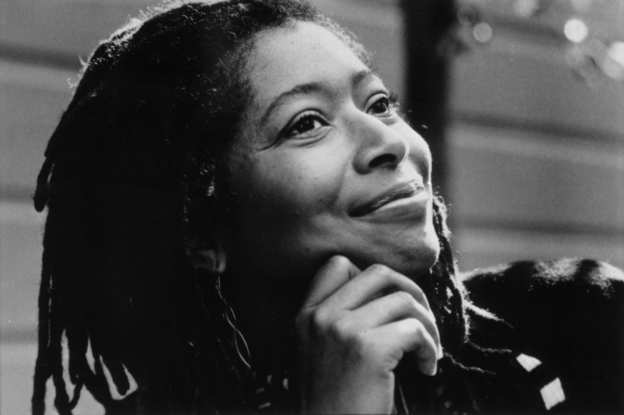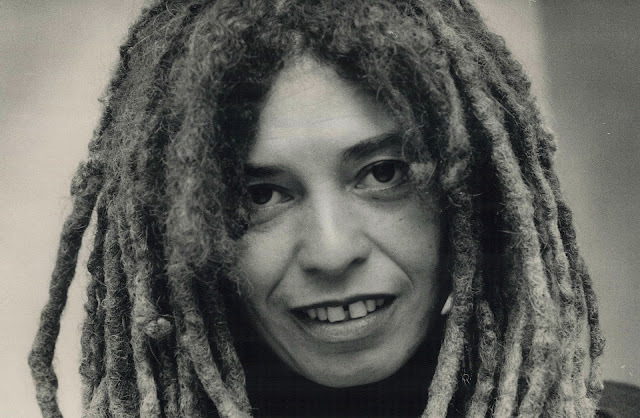“Bob Marley is the person who taught me to trust the universe enough to respect my hair.” ~ Alice Walker
In 2016 the 11th U.S. Circuit Court of Appeals ruled that it was not discriminatory to make hiring and firing decisions based on whether someone has dreadlocks.
The suit, brought by the Equal Employment Opportunity Commission against Catastrophe Management Solutions, argued that dreadlocks are a “racial characteristic” and that using them to deny the hiring of someone is inherently discriminatory and a violation of the Civil Rights Act of 1964’s Title VII.
The court of appeals ruled that hair is not an “immutable physical characteristic,” that a person’s appearance is, in this respect, changeable and therefore not protected. I suppose this is true, seeing as today all sorts of folks can don a head of locs regardless of race or ethnicity.
Image of a Sadhu in Varanasi, India, 2009. Via Wikimedia by Pierre-Emmanuel BOITON
Matted hair is a feature of Hindu sadhus and also familiarly associated with Rastafari, who adopted the style in the 1950s as an authentic expression of their faith and to reinforce their non-conformist ideology.1. For the Rastafari, dredslocs were potent symbol of both one’s spiritual commitment and cultural resistance.2.
Angela Davis. Photo by Andrew Stawicki, 1988, Toronto Star Archives
During the 1980s a number of prominent African Americans (such as Basquiat, Tracy Chapman, Angela Davis, Whoopi Goldberg, and Alice Walker) brought attention to the style, contributing to its adoption by the mainstream. There was pushback at the time to this “Americanization of dredlocs,” notably in a 1991 Essence editorial entitled “The Dreaded Decision” by Naadu Balnkson. Did the fashionability of dreds come at the expense of their religious and cultural significance? Criticism was leveled at black Americans for secularizing a religious practice, and at those outside the African American community for cultural appropriation.3.
This 2016 court decision shows that regardless of whether dredlocs are considered ‘mainstream’ or not, they continue to be used as an excuse to discriminate, harass, intimidate, and oppress.
L: François Fleischbein, Portrait of Betsy (his housekeeper, a free woman of color), 1837. The Historic New Orleans Collection, 1985.212 / M: Source /
R: Jacques Guillaume Lucien Amans, Creole in a Red Headdress, circa 1840. The Historic New Orleans Collection, 2010.0306
R: Jacques Guillaume Lucien Amans, Creole in a Red Headdress, circa 1840. The Historic New Orleans Collection, 2010.0306
Afro hair has historically been demeaned -- an affront to white American culture. Laws against the public expression of natural, Afro hairstyles go back at least as far as the late 1700s in New Orleans, when women of African and multiracial heritage were banned from wearing their natural hair in public by Tignon laws.4. These sumptuary laws required Creole women to wear a headcovering (a tignon) and were implemented to curtail the growing influence of the free black population.5.
In The Hair Dilemma, an academic paper published by the Duke Journal of Gender Law & Policy in 2007, the authors draw attention to other litigation around Afro hairstyles including McManus v. MCI Communications Corp. (2000), in which McManus, a Black woman, argued that she was fired for wearing her hair in braids and dreadlocks; Hollins v. Atlantis Co. (1999), in which the plaintiff who came to work with her hair in “finger waves” claimed that her employer’s policy prohibiting “eye catching” hairstyles was discriminatory; and Rogers v. American Airlines, Inc. (1981), where a Black woman was fired for wearing her hair in braids. “These cases demonstrate how “ethnic” hairstyles are not welcome in the corporate world.’
 |
| http://www.klassykinks.com/tiana-parker/ |
And in Tennessee, you must have a license (acquired at great time and cost) to braid hair or face stiff fines, as reported just this week at Forbes.com. Author Minh-Ha T. Pham notes, “White designers like Marc Jacobs put fake dreadlocks on white models and make tons of money - all without permission - but Black women doing Black people's hair are being heavily fined for not having a license.”
Such legislation and work/school policies shame and degrade women for their hair. This institutional racism can lead to internalized racism, whereby women are made to feel their Afro hair is unkempt or unattractive. In order to conform to Western hair ideals and white standards of beauty, these women endure chemical straighteners or expensive weaves or extensions.
However, social awareness can change policy. Tiana’s school reversed their policy shortly after the student transferred. And interestingly, while the Army has long outlawed dredlocs (Army Regulation 670–1, 2014 policy stating: Any style of dreadlock (against the scalp or free-hanging) is not authorized. Braids or cornrows that are unkempt or matted are considered dreadlocks and are not authorized), a 2017 Army directive countered that prohibition with the following language:
One Army Captain noted, via a New York Times article, “It caused a lot of unnecessary stress. It was an exhausting 14 years.”
Female soldiers may wear dreadlocks/locks in accordance with the guidance in
paragraph 3-2a(3)(f) for braids, cornrows, and twists.
One Army Captain noted, via a New York Times article, “It caused a lot of unnecessary stress. It was an exhausting 14 years.”
Even when she worked to stay within the regulations, there was constant scrutiny by higher-ups, she said, adding that black women felt as if they were “walking targets” because the regulations were subject to interpretation.
But, without a doubt, written and unwritten rules about “grooming” and “dress codes” serve as means to discriminate and devalue Blackness. These rules have allowed schools, corporations, and even the United States military to distort social norms and limit the beauty of Blackness by condemning hairstyles such as cornrows, braids, twists, and dreadlocks.
Hair “not only symbolizes the self but, in a very real sense, it is the self since it grows from and is part of the physical human body.”6.
1. Barry Chevannes in Rastafari and Other African-Caribbean Worldviews, Rutgers University Press, 1997, p77 and p82)
In the late 1940s a Rastafari group called the Youth Black Faith believed leaving hair uncombed was the truer reading of the scriptures. (The Nazarite Vow in the book of Numbers states: “'All the days of his vow of separation no razor shall pass over his head. He shall be holy until the days are fulfilled for which he separated himself to the LORD; he shall let the locks of hair on his head grow long.” http://biblehub.com/numbers/6-5.htm)
Chevannes asserts that Rastafari embraced dredlocs to maintain associations with the unkempt and outcast and in opposition to White and mainstream Jamaican cultural identity. Another historical interpretation is that dredlocs were adopted by Rastafari “out of admiration and reverence for the fearless resistance of the Kikuyu soldiers of the Mau Mau rebellion in Kenya.” (see Hair Story page 121)
2. I use the spelling dredlocs over dreadlocks, in deference to those who ascribe the word’s derivation as being from the description of arriving slaves as “dreadful.” However, Chevannes explains that dreadlocks comes from The Dreadfuls (or the Warriors), named for those more aesthetic and disciplined. “The term Dreadful and Warrior reflected the manner in which the ascetics behaved: constantly ‘at war’ with the neglectful, in whom they inspired dread.” p84
3. Ayana D. Byrd and Lori L. Tharps, Hair Story: Untangling the Roots of Black Hair in America, St. Martin’s Griffin, 2014, page 123.
4. The word tignon, pronounced tiyon, was a regional term in New Orleans for headscarf. It derived from the French word chignon which, in the late 18th century, referred to a hairstyle where the hair was pulled back in twists or knots.
5. The tignon laws were intended to “force the free women of color to symbolically reestablish their ties to slavery by wearing the kerchief, the garment traditionally worn by slave women to signify their status as workers. (Plaçage and the Louisiana Gens de Couleur Libre: How Race and Sex Defined the Lifestyles of Free Women of Color” by Joan M. Martin in Creole: The History and Legacy of Louisiana's Free People of Color edited by Sybil Kein, p. 62.)
6. Anthony Synnott, ‘Shame and Glory: A Sociology of Hair,’ British Journal of Sociology, 38 (3), p404.





